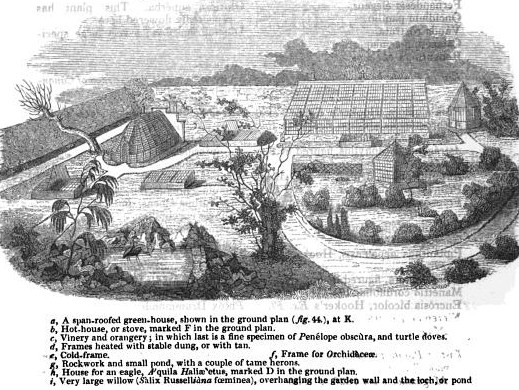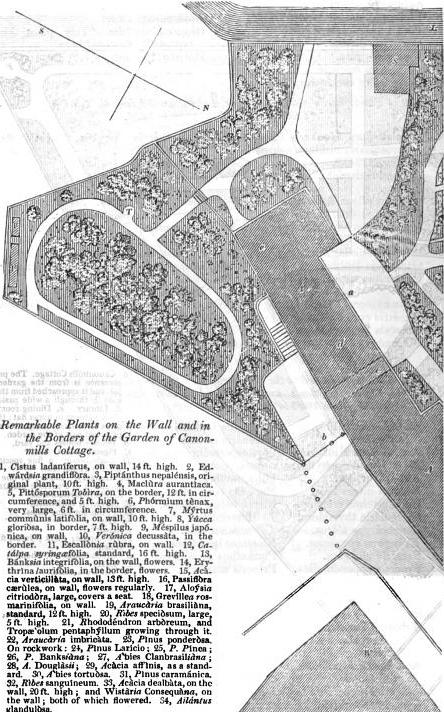Patrick Neill (naturalist) on:
[Wikipedia]
[Google]
[Amazon]
Patrick Neill (25 October 1776 – 3 September 1851) was a British printer and horticulturalist, known as a naturalist. A founding member, and the first secretary, of both the  Neill's residence at Canonmills Cottage (in
Neill's residence at Canonmills Cottage (in  He served as president of the
He served as president of the
Wernerian Natural History Society
The Wernerian Natural History Society (12 January 1808 – 16 April 1858), commonly abbreviated as the Wernerian Society, was a learned society interested in the broad field of natural history, and saw papers presented on various topics such as m ...
(1808–49) and the Caledonian Horticultural Society (1809–49), he is mainly remembered today for having endowed the Neill Medal of the Royal Society of Edinburgh
The Royal Society of Edinburgh (RSE) is Scotland's national academy of science and letters. It is a registered charity that operates on a wholly independent and non-partisan basis and provides public benefit throughout Scotland. It was establis ...
.
Neill' works include ''A Tour Through Some of the Islands of Orkney and Shetland'' (1806), which caused much public debate at the time, due to its descriptions of the economic misery of the islanders. He also authored the ''Gardening'' article in the seventh edition of the ''Encyclopædia Britannica
The is a general knowledge, general-knowledge English-language encyclopaedia. It has been published by Encyclopædia Britannica, Inc. since 1768, although the company has changed ownership seven times. The 2010 version of the 15th edition, ...
''. This article was subsequently expanded and published as a separate book under the title of ''The Fruit, Flower, and Kitchen Garden'', which was popular and ran through several editions.
When the Nor Loch
The Nor Loch, also known as the Nor' Loch and the North Loch, was a man-made loch formerly in Edinburgh, Scotland, in the area now occupied by Princes Street Gardens and Edinburgh Waverley railway station, Waverley station which lie between t ...
was drained in 1820, Neill was commissioned to plan the scheme of planting of 5 acres of land, which is now West Princes Street Gardens. This included the planting of 77,000 trees and shrubs.
The rosaceous genus ''Neillia
''Neillia'' is a genus of the botanical family Rosaceae. They are deciduous shrubs or subshrubs. They produce clusters of terminal or axillary flowers, and have dry dehiscent fruits.Edinburgh
Edinburgh is the capital city of Scotland and one of its 32 Council areas of Scotland, council areas. The city is located in southeast Scotland and is bounded to the north by the Firth of Forth and to the south by the Pentland Hills. Edinburgh ...
on 25 October 1776, and spent his life there. He became the head of the large printing firm of Neill & Co., of Edinburgh, but during the last 30 years of his life he took little active part in its management. Early in his career he devoted his spare time to natural history, especially botany
Botany, also called plant science, is the branch of natural science and biology studying plants, especially Plant anatomy, their anatomy, Plant taxonomy, taxonomy, and Plant ecology, ecology. A botanist or plant scientist is a scientist who s ...
and horticulture
Horticulture (from ) is the art and science of growing fruits, vegetables, flowers, trees, shrubs and ornamental plants. Horticulture is commonly associated with the more professional and technical aspects of plant cultivation on a smaller and mo ...
. The Wernerian Natural History Society
The Wernerian Natural History Society (12 January 1808 – 16 April 1858), commonly abbreviated as the Wernerian Society, was a learned society interested in the broad field of natural history, and saw papers presented on various topics such as m ...
was established in 1808, and in 1809 the Caledonian Horticultural Society was founded. Neill was the first secretary of both societies, holding the latter post for forty years.
 Neill's residence at Canonmills Cottage (in
Neill's residence at Canonmills Cottage (in Canonmills
Canonmills is a district of Edinburgh, the capital of Scotland. It lies to the south east of the Royal Botanic Garden at Inverleith, east of Stockbridge and west of Bellevue, in a low hollow north of Edinburgh's New Town. The area was formerl ...
, then near the city of Edinburgh, now a suburb) was open to visitors; and his garden was noted, with William Brackenridge as head gardener before he moved to Berlin. He was Fellow of the Linnean Society
The Linnean Society of London is a learned society dedicated to the study and dissemination of information concerning natural history, evolution, and taxonomy. It possesses several important biological specimen, manuscript and literature collec ...
and the Royal Society of Edinburgh
The Royal Society of Edinburgh (RSE) is Scotland's national academy of science and letters. It is a registered charity that operates on a wholly independent and non-partisan basis and provides public benefit throughout Scotland. It was establis ...
, and honorary LLD of the University of Edinburgh
The University of Edinburgh (, ; abbreviated as ''Edin.'' in Post-nominal letters, post-nominals) is a Public university, public research university based in Edinburgh, Scotland. Founded by the City of Edinburgh Council, town council under th ...
.
 He served as president of the
He served as president of the Botanical Society of Edinburgh
Botany, also called plant science, is the branch of natural science and biology studying plants, especially their anatomy, taxonomy, and ecology. A botanist or plant scientist is a scientist who specialises in this field. "Plant" and "botany ...
in 1842–43.
Death and legacy
A short time before his death he became enfeebled by a stroke of paralysis, and after several months of suffering he died at Canonmills on 3 September 1851, and was buried inWarriston Cemetery
Warriston Cemetery is a cemetery in List of graveyards and cemeteries in Edinburgh, Edinburgh. It lies in Warriston, one of the northern suburbs of Edinburgh, Scotland. It was built by the then newly-formed Edinburgh Cemetery Company, and o ...
, on the western wall in the extreme south-west corner of the original cemetery, just west of the archway to the southern extension. His tombstone states that he was "distinguished for literature, science, patriotism, benevolence, and piety". The memorial was restored by the Friends of Warriston Cemetery 2014/2015.
The Royal Society of Edinburgh has John Syme
John Syme RSA (17 January 1795 – 3 August 1861) was a Scottish portrait painter.
Life
A nephew of Patrick Syme, he was born in Edinburgh to Alexander Syme and Catharine Johnston on 17 January 1795. He studied in the Trustees' Academy on ...
's portrait of Neill.
He died unmarried, and among his various charitable bequests was one of £500 to the Caledonian Horticultural Society to found a medal for distinguished Scottish botanists or cultivators (now the ''Dr Patrick Neill Medal''), and a similar sum to the Royal Society of Edinburgh for a medal to distinguished Scottish naturalists. He is botanically commemorated by the rosaceous genus ''Neillia
''Neillia'' is a genus of the botanical family Rosaceae. They are deciduous shrubs or subshrubs. They produce clusters of terminal or axillary flowers, and have dry dehiscent fruits.
Edinburgh is indebted to Neill for the scheme of the West Princes Street Gardens. In 1820, that portion of the north loch was drained, and five acres of ground were laid out and planted with seventy-seven thousand trees and shrubs under his direction. He also intervened to preserve several antiquities that were on the point of being demolished.
''Parks & Gardens UK'' page
;Attribution {{DEFAULTSORT:Neill, Patrick 1776 births 1851 deaths 19th-century British botanists 19th-century Scottish businesspeople Scientists from Edinburgh Burials at Warriston Cemetery Fellows of the Royal Society of Edinburgh Fellows of the Linnean Society of London Scottish antiquarians 19th-century Scottish botanists Scottish encyclopedists Scottish garden writers Scottish horticulturists Scottish naturalists Scottish printers Scottish travel writers Fellows of the Society of Antiquaries of Scotland People associated with Shetland
Works
In 1806 appeared his ''Tour through Orkney and Shetland'', a work which gave rise to discussion because of its reports of poverty. In 1814 he issued a translation, ''An Account of the Basalts of Saxony, from the French of Dubuisson, with Notes'', Edinburgh. He was the author of the article "Gardening" in the seventh edition of the ''Encyclopædia Britannica
The is a general knowledge, general-knowledge English-language encyclopaedia. It has been published by Encyclopædia Britannica, Inc. since 1768, although the company has changed ownership seven times. The 2010 version of the 15th edition, ...
'', and it was subsequently published as ''The Flower, Fruit, and Kitchen Garden'' (several editions). In 1817 Neill, with two other deputies from the Caledonian Society, made a tour through the Netherlands and the north of France, and he wrote an account of it, which was published in 1823.
Family
His great niece was the Scottish lady golfer andFirst World War
World War I or the First World War (28 July 1914 – 11 November 1918), also known as the Great War, was a World war, global conflict between two coalitions: the Allies of World War I, Allies (or Entente) and the Central Powers. Fighting to ...
heroine, Margaret Neill Fraser
Margaret (Madge) Neill Fraser (4 June 1880 – 8 March 1915) usually known as Madge, was a Scottish First World War nurse and notable amateur golfer. She represented Scotland at international level every year from 1905 to 1914.
Life
Margar ...
who died while serving in Serbia
, image_flag = Flag of Serbia.svg
, national_motto =
, image_coat = Coat of arms of Serbia.svg
, national_anthem = ()
, image_map =
, map_caption = Location of Serbia (gree ...
.
Botanical Reference
References
External links
''Parks & Gardens UK'' page
;Attribution {{DEFAULTSORT:Neill, Patrick 1776 births 1851 deaths 19th-century British botanists 19th-century Scottish businesspeople Scientists from Edinburgh Burials at Warriston Cemetery Fellows of the Royal Society of Edinburgh Fellows of the Linnean Society of London Scottish antiquarians 19th-century Scottish botanists Scottish encyclopedists Scottish garden writers Scottish horticulturists Scottish naturalists Scottish printers Scottish travel writers Fellows of the Society of Antiquaries of Scotland People associated with Shetland